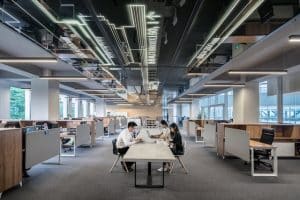In the realm of modern workplace design, the impact of lighting and decor on productivity is a topic that warrants thoughtful consideration.
As interior fit-out contractors with extensive experience, we’ve observed first-hand how the physical environment can significantly influence the mood, health, and efficiency of employees.
This piece delves into the nuanced ways in which lighting and decor not only shape the aesthetics of a workspace, but also its functionality and the well-being of those within it.
The Importance of Lighting
The significance of lighting in the workplace cannot be overstated. Natural light, in particular, is a coveted asset for any workspace design. It has been consistently linked with increased productivity, better mood, and a decrease in eye strain and headaches, thereby reducing absenteeism and boosting employee engagement.
However, the reality of architectural limitations means natural light cannot always be the primary source of illumination. This is where strategic lighting design comes into play.
Artificial lighting solutions can mimic natural light, promoting alertness and reducing fatigue. Colour temperature is a critical factor; cool white lights are invigorating and are best for areas requiring focus and concentration, while warmer tones suit collaborative spaces, creating a relaxed atmosphere that encourages open communication.
Dynamic lighting systems that adjust throughout the day can align with our natural circadian rhythms, further enhancing employee productivity and well-being.
The Role of Interior Decor
Decor encompasses all elements of a workspace’s interior design, from the colour of the walls to the furniture and art. The psychology of colour suggests that different hues can evoke different emotions and behaviours – blue, for example, is often associated with productivity, while green can reduce stress.
Integrating brand colours can also enhance a sense of identity and belonging among employees.
Furniture and layout play a crucial role in supporting a productive environment. Ergonomic furniture not only reduces the risk of musculoskeletal disorders but also signals to employees that their well-being is a priority.
Flexible workspaces that cater to different tasks and working styles can foster collaboration and creativity, allowing employees to choose how and where they work best.
Art and greenery are not merely decorative; they’re functional. Art can inspire and evoke creativity, while plants can improve air quality and reduce stress, creating a more pleasant and productive workplace.
In conclusion, our interior fit out contractors understand that the design of a workspace – from lighting to decor – is not just about creating a visually appealing environment. It’s about crafting spaces that inspire, energise, and support the people who use them every day. The right lighting and decor can transform a workplace, turning it into a catalyst for creativity, well-being, and, ultimately, productivity.


